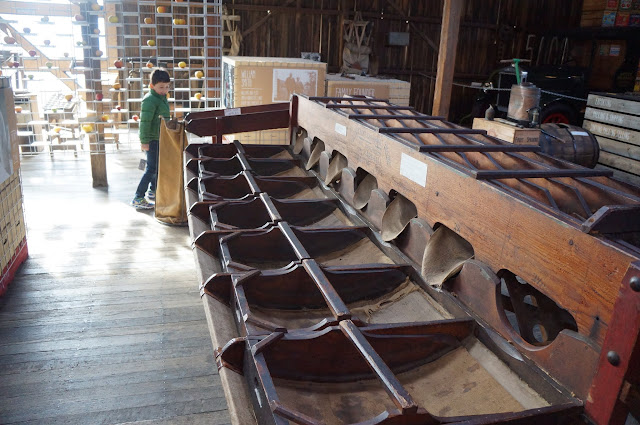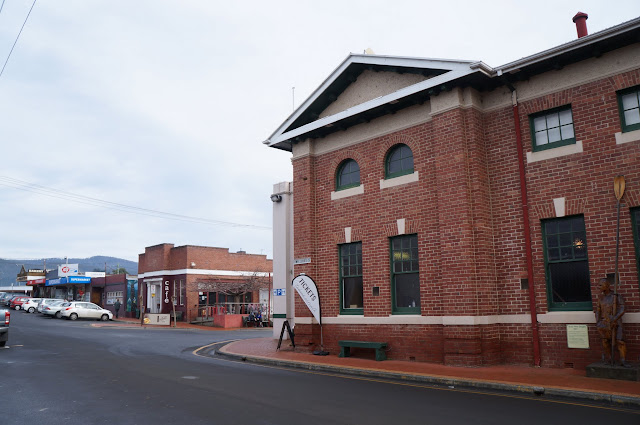When I was a university student in Canberra I had a couple of house mates from Tasmania. Apart from complaining that Canberra felt colder than Tassie, one of them was Young Einstein incarnate.
"G'day, I'm Stuart from Tasmania!" He would say with a broad Taswegian accent, much like that of Yahoo Serious's character.
Stuart was also student of physics and lover of beer (Young Einstein splits the beer atom), but more than that, he was the son of an Apple farmer. His love of Tasmania's most famous produce was such that his beloved computer was the obsolete Apple IIGS (I claimed that the GS stands for Granny Smith).
As visitors to the Apple Isle we were determined to sample its produce. Saturday mornings see the famous Salamanca Markets within a short walking distance from our hotel. Yes, it's a tourist attraction and there are some of the standard Australian market crafts, clothes and foods, but there are also some really good stuff.
It's about 15 years since we last visited Tassie and it is nice to see Silly Billy's crazy metal sculptures were still there. Alex wanted his own. Sadly our favourite cake stall is gone, the owner's house having burned down in the bushfires. Plenty of other interesting things, cakes, tarts and chocolates (including Federation Chocolates), fresh fruit and vegetables and even jars of wasabi cherry preserves.
After dropping our purchases back at the hotel we set off for the Huon Valley. First stop, The Apple Shed. Alex enjoys playing with the old apple sorting machine in the museum. Sadly it is not possible to try samples of the huge number of apple types on display. Commercially produced apple cultivars are bred for a number of characteristics, including longer growing seasons, resistance to bruising for packaging and transport and for longer storage lives. As these are not always shared by many of those on display their availability remains restricted.
 |
| The Apple Shed |
 |
| Apple sorter |
 |
| Apple collection |
 |
| Yum! |
The Apple Shed exists mainly to produce and sell Willy Smith Cider but their apple pie is pretty special. Not so the reconstituted juice for sale.
We continue down the Huon Highway, alongside the river, stop to buy a bag of apples from an unattended roadside shed. The scenery is so pretty, the river serene, small sail boats moored in the utterly flat waters beyond the dry rushes. Black swans glide between them.
Alongside were apple farms, trees naked but for the red spots of unharvested apples, others piled near the base of the trees to be picked at by birds.
Like on our trip north and east on the previous day there are signs that all is not right. Shops and houses shuttered, for sale or for lease. It feels rather like Japan as changing demographics the flight to the big cities takes its toll.
I can understand. As someone who was born in a big city the countryside can feel limiting. There's no anonymity in a small town. Sometimes the sense of community is nice, sometimes it is claustrophobic. Opportunities pass you by, especially if you are young. Yet as I age I do feel a yearning for somewhere peaceful, where life is not a struggle of commuting in a place that seems ready to collapse under the weight of its populace. However, a town cannot exist just as a retirement home without the vigour of youth.
These towns can also be considered victims of globalisation as factories move offshore and more produce is imported from cheaper locations. Even though the total demand for products has decreased, so has the level of protection and the price that consumers are willing to pay, while the thirst for maximising profits continues unabated.
Yet here we are in Tasmania in search of locally grown produce and goods, in search of novelty and craftsmanship, the very things that cannot be imported. It is an interesting tension.
Attracted by the signs advertising a local farmers market we stop at Geeveston. The market itself consists of four or five tiny stalls in a room with little on offer. There is an amazing range of flavoured chocolate on sale at the nearby lolly shop. At the bakery across the road the salmon pie is so good. I love these country bakeries. Their range differs so much from what you get in Sydney these days.
Our main point for coming here is the Tahune Airwalk. We purchase tickets from the Forestry Centre, then set off down the winding and narrow forestry road to the centre. B chides me for being nervous as we swerve around curves and down the slopes.
From the visitors centre we set off first along the Airwalk, walking across the river and under the damp forest canopy, past fallen trees covered with moss and ferns, until we reach the suspended metal walkways. Now we look down at the canopy and the variety of trees and shrubs growing below. There are gorgeous views at the confluence of the Huon and Picton Rivers and across to the mountains, glimpsing a snowcapped peak.
Next is the Swinging Bridges Walk, which takes us down through more of the forest. It's cool and very beautiful, with so many little vignettes. Water flowing out through the centre of a fallen log or beneath the roots of a still growing tree, tiny jungles of moss and fungus, the sounds of silence and water.
There are long swinging bridges across both the Huon and Picton Rivers, their waters as brown as cola from the plant tannins, but otherwise clear. B feels motion sick crossing them, but Alex laughs as our rapid bounces reflect off the other end of the bridge to hit us back.
It's a fairly long walk and by the time we return to the visitors centre they lack the energy to continue on to the Huon Pine Walk, which is a pity because I'm not sure we actually saw one of the pines. But it is getting late and we have no wish to drive out of here in the dark.
Rather than take the Huon Highway all the way back to Hobart, we turn on to the Channel Highway at Huonville and are treated to some views of the other side of the Huon River. Darkness is coming and we turn off after Cygnet for another winding ride through the hills. Below us are farms alongside a pretty creek flowing through green fields and under bare winter trees.
We return to the coast along the other side, more winding roads, until we reach the distinctive cylindrical hotel of the Wrest Point Casino and Sandy Bay, past B's old university. I pop into the Woolworths and pick up more supplies, for I am cooking dinner again tonight.
Exhausted, we return to the hotel, where I cook up a meal of fish stew and rice using ingredients from Bicheno and the markets.
Once again Tasmania has stunned us with beauty.











































Comments